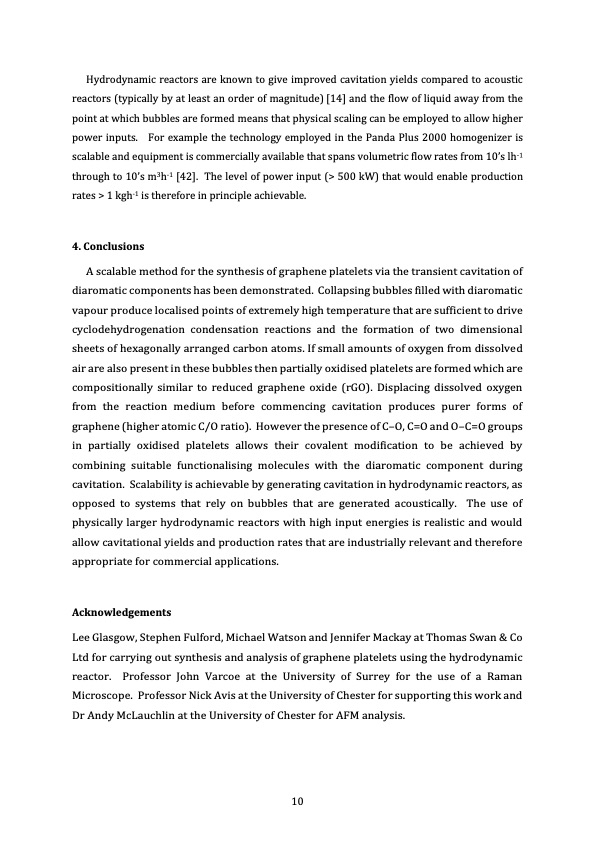
PDF Publication Title:
Text from PDF Page: 011
Hydrodynamic reactors are known to give improved cavitation yields compared to acoustic reactors (typically by at least an order of magnitude) [14] and the flow of liquid away from the point at which bubbles are formed means that physical scaling can be employed to allow higher power inputs. For example the technology employed in the Panda Plus 2000 homogenizer is scalable and equipment is commercially available that spans volumetric flow rates from 10’s lh-1 through to 10’s m3h-1 [42]. The level of power input (> 500 kW) that would enable production rates > 1 kgh-1 is therefore in principle achievable. 4. Conclusions A scalable method for the synthesis of graphene platelets via the transient cavitation of diaromatic components has been demonstrated. Collapsing bubbles filled with diaromatic vapour produce localised points of extremely high temperature that are sufficient to drive cyclodehydrogenation condensation reactions and the formation of two dimensional sheets of hexagonally arranged carbon atoms. If small amounts of oxygen from dissolved air are also present in these bubbles then partially oxidised platelets are formed which are compositionally similar to reduced graphene oxide (rGO). Displacing dissolved oxygen from the reaction medium before commencing cavitation produces purer forms of graphene (higher atomic C/O ratio). However the presence of C–O, C=O and O–C=O groups in partially oxidised platelets allows their covalent modification to be achieved by combining suitable functionalising molecules with the diaromatic component during cavitation. Scalability is achievable by generating cavitation in hydrodynamic reactors, as opposed to systems that rely on bubbles that are generated acoustically. The use of physically larger hydrodynamic reactors with high input energies is realistic and would allow cavitational yields and production rates that are industrially relevant and therefore appropriate for commercial applications. Acknowledgements Lee Glasgow, Stephen Fulford, Michael Watson and Jennifer Mackay at Thomas Swan & Co Ltd for carrying out synthesis and analysis of graphene platelets using the hydrodynamic reactor. Professor John Varcoe at the University of Surrey for the use of a Raman Microscope. Professor Nick Avis at the University of Chester for supporting this work and Dr Andy McLauchlin at the University of Chester for AFM analysis. 10PDF Image | graphene platelets with partial oxidation via cavitation

PDF Search Title:
graphene platelets with partial oxidation via cavitationOriginal File Name Searched:
Sonochemistry-Chester-Rep.pdfDIY PDF Search: Google It | Yahoo | Bing
Salgenx Redox Flow Battery Technology: Power up your energy storage game with Salgenx Salt Water Battery. With its advanced technology, the flow battery provides reliable, scalable, and sustainable energy storage for utility-scale projects. Upgrade to a Salgenx flow battery today and take control of your energy future.
| CONTACT TEL: 608-238-6001 Email: greg@infinityturbine.com | RSS | AMP |